Update: Jane wound up using most of my astrophotos below in her July NASA What’s Up podcast. Check it out!
The forecast was for a very temperate desert evening, so six of the Old Town Sidewalk Astronomers headed off to the Colorado Desert to play outside all night. Seeing was forecast poor, but actual conditions seemed much better.
Jane packed her 17.5-inch dob, and I loaded the Astro-Physics Traveler 102mm f/6 refractor to do some astrophotography. The highlight of the evening promised to be comet McNaught 2009R1, but it wouldn’t be available until the pre-dawn hours. That left me with late spring galaxies and summer Milky Way targets. (Jane also had a great target which she’ll be writing about!)
I tried the M84-M86 region of Virgo last month with the AP180, but the field of view was too narrow. I knew it’d be a good warm-up for tonight. The grey scale version looks better to me than the color rendition.
Jane and I both love piggyback pictures, taken at “naked eye” scale. This is one of “the teapot” and the Sagittarius Milky Way. The full-size image isn’t bad, but it looks better scaled back a bit. Click for the really big version. It’s fun looking through all the dark nebulae and bright clusters.
Deep in the Milky Way just above the spout of the teapot is Barnard’s famous “Ink Spot” dark nebula, B86.
I started out trying to fit M8 “The Lagoon Nebula” in the same field as the nearby Trifid Nebula, but they wouldn’t quite fit. So I did 15 minutes just on M8, and love the result.
I love hunting for the Pipe Nebula, a huge dark nebula best seen in binoculars. Seeing the Pipe is a portent of great transparency and dark skies. The detail photo here is centered on the Pipe, taken piggyback with the 20D. Click for the full field, see if you can find the Pipe there.
Ever since I started doing astrophotography, I’ve been waiting for the opportunity to shoot M16 The Eagle Nebula. This nebula is famous for its Hubble Space Telescope image showing the embedded dark nebulae as stellar nurseries, the “Pillars of Creation.”
I only did one fifteen minute exposure. By then it was getting quite late, and I need to catch a couple hours of sleep before getting up to catch comet McNaught. Naturally that means I had an airplane fly through the image! Should I wipe it out with Photoshop? Naaaah.
Jane and I napped for a couple of hours, with alarms set to catch comet McNaught in the early hours
This image of McNaught is made from ten one-minute exposures. They’re stacked with the comet centered, so the background stars are streaked. It looks out of focus, but it’s actually just the motion of the comet you see.
I also took my ten comet pictures and made a little animation that shows the motion of the comet against the background stars over the course of 15 minutes or so.

Comet McNaught moves against background stars over fifteen minutes. The sky is also brightening with dawn towards the end.
I was also taking piggyback images of the sky where McNaught was lurking. Can you find the little green dot near the center?
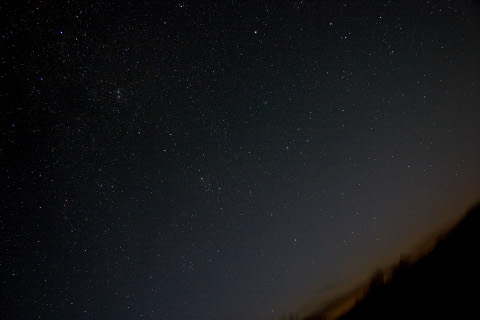
This is the "naked eye" view of the sky where Comet McNaught can be found. The horizon is tilted as an artifact of the way the mount holds the telescope and camera mounted piggyback. Click for the full scale version.
Here’s a little close up of the beautiful binocular cluster Collinder 39 in Perseus with the green dot of McNaught just to the right. The color was evident in binoculars even.
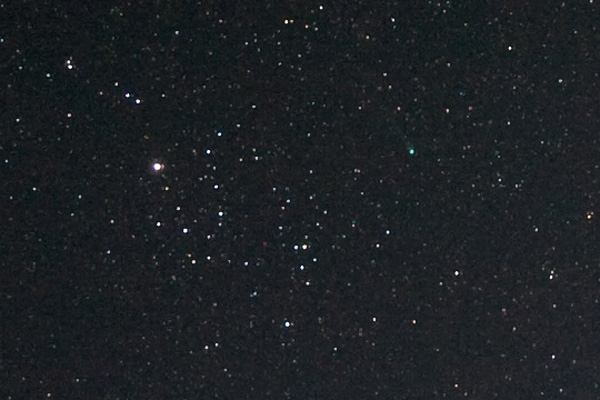
This is somewhat the view in a pair of binoculars of large open cluster Collinder 39. See the green dot of comet McNaught slightly up and right of center.
What a fabulous night of astronomy! Shirt sleeves or light jacket all evening.
Equipment notes: The telescope shots were taken with an SBIG ST-4000XCM one-shot color CCD camera, at prime focus of an Astro-Physics Traveler 105mm f/6 refractor. The mount is an AP Mach 1 GTO on a wooden tripod. The piggyback photos were taken with an unmodified Canon 20D digital SLR camera.
Update: Be sure to see Jane’s A Ten Planet Night report from the same evening!

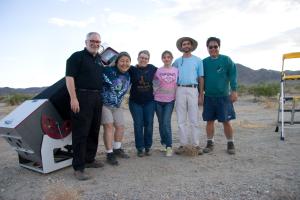
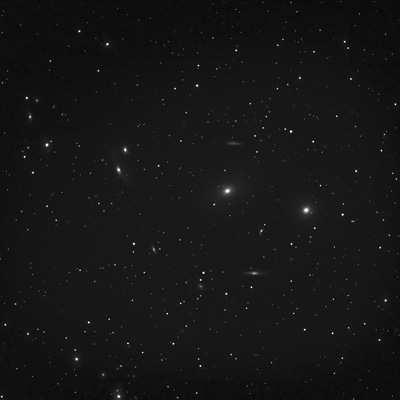
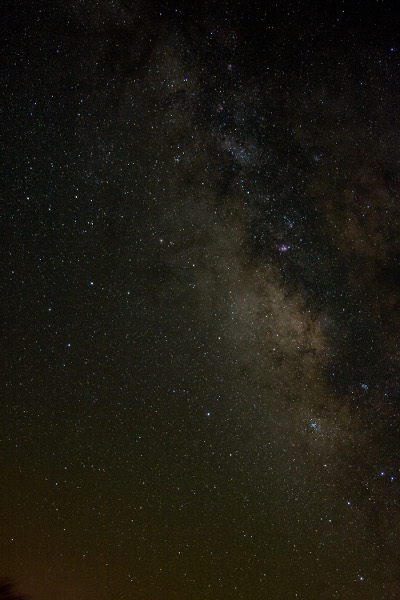
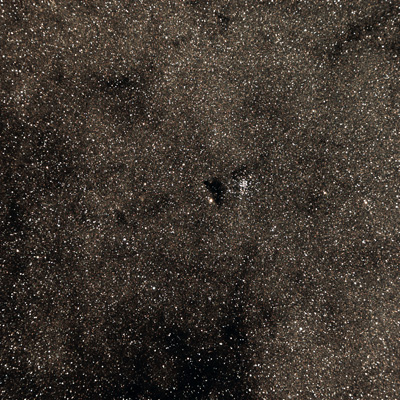

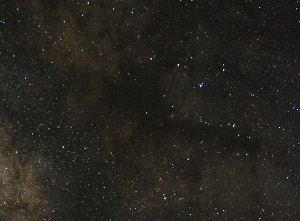
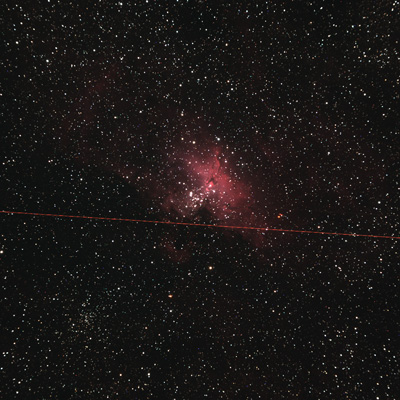

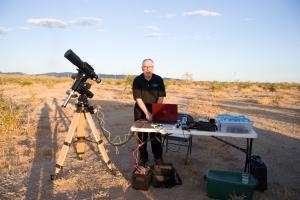
Nice job Morris! I like the pipe nebula. It is my #1 way to get a gauge on the night’s transparency. I should bring the 45cm Litebox out someday. I was at Little Blair Valley for the night. Unfortunately that wind made observing ‘challenging’. Stayed up for McNaught rather than risk sleeping through.
—-report from LBV @ 3:30am 6/13/2010 or 10:30 2010/06/13 UT) ——–
I easily observed this comet at about 3:30am this morning under dark skies out in the Anza Borrego desert. In 10×50 Orion Ultraview binoculars the comet was an obvious greenish fuzzy star with a tail about 1.5 to 2 degrees long. Pretty site just above the ridge line at the site. Wish I had thought of bringing my DLSR and tripod along.
In my 45cm f/4.5 Newtonian telescope with a 31mm eyepiece (about 70x) the color seemed to be more a blue-green. The nucleus was very bright with a round coma. The tail was needle like straight to the NW but near the coma you coud see a lot more ‘spikes’ or ‘jets’ (none anti).
Around 4am when I turned in, I tried to see it naked eye. Knowing exactly where it was in relational to the Perseus Association cluster allowed me to just eek it out. I’d not have seen it if I had not known exactly where to look. Prolly 5 or 6th mag
Hmm… How come Jane can get away with only 1 virtual counterweight spring? I need two on each side….

I use an 80mm Finder, Telrad, Parracor, and 31mm Nagler.
Just so you’re not too disappointed, the scaled-down versions of these shots hide many flaws that become obvious in the full-res versions.
Astrotaining – Thanks!
Jeff, maybe my mirror is heavier than yours or some of your alterations changed the center of gravity? I can add a 31 Nagler and still don’t need and additonal counterweight. Neener Neener neener 😉 But, really that would be a question for Mr. Peckham. 😉
[…] Mojo’s report/astrophotos from the same night […]
Love the animation
Dee
I absolutely love the animation for the McNaught comet. You people are absurdly wonderful to allow us so much visibility into astronomy!!!
Thanks so much from the bottom of my heart, which is itself a “dark nebula”.
Best Regards
ateeq
[…] more of Mojo’s photos from this observing […]
[…] of a slow month for observing the planets. So get out of town, and enjoy dark skies while waiting for the summer Milky Way to […]